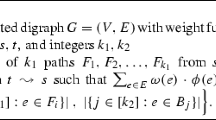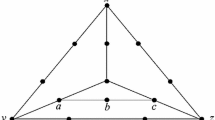Abstract
Given a set S of starting vertices and a set T of terminating vertices in a graph G = (V,E) with non-negative weights on edges, the minimum Steiner network problem is to find a subgraph of G with the minimum total edge weight. In such a subgraph, we require that for each vertex s \({\in}\) S and t \({\in}\) T, there is a path from s to a terminating vertex as well as a path from a starting vertex to t. This problem can easily be proven NP-hard. For solving the minimum Steiner network problem, we first present an algorithm that runs in time and space that both are polynomial in n with constant degrees, but exponential in |S|+|T|, where n is the number of vertices in G. Then we present an algorithm that uses space that is quadratic in n and runs in time that is polynomial in n with a degree O(max {max {|S|,|T|}−2,min {|S|,|T|}−1}). In spite of this degree, we prove that the number of Steiner vertices in our solution can be as large as |S|+|T|−2. Our algorithm can enumerate all possible optimal solutions. The input graph G can either be undirected or directed acyclic. We also give a linear time algorithm for the special case when min {|S|,|T|} = 1 and max {|S|,|T|} = 2.
The minimum union paths problem is similar to the minimum Steiner network problem except that we are given a set H of hitting vertices in G in addition to the sets of starting and terminating vertices. We want to find a subgraph of G with the minimum total edge weight such that the conditions required by the minimum Steiner network problem are satisfied as well as the condition that every hitting vertex is on a path from a starting vertex to a terminating vertex. Furthermore, G must be directed acyclic. For solving the minimum union paths problem, we also present algorithms that have a time and space tradeoff similar to algorithms for the minimum Steiner network problem. We also give a linear time algorithm for the special case when |S| = 1, |T| = 1 and |H| = 2.
Similar content being viewed by others
References
Y.P. Aneja “An integer linear programming approachto the Steiner problem in graphs,”Networks, vol. 10, pp. 167–178, 1980.
G. Dahl “Directed Steiner problems with connectivity constraints,”Discrete Applied Math., vol. 47, pp. 109–128, 1993.
S.E. Dreyfus and R.A. Wagner “The Steiner problem in graphs,”Networks, vol. 1, pp. 195–207, 1972.
M.L. Fredman and R.E. Tarjan “Fibonacci heaps and their uses in improved network optimization algorithms,”Journal of ACM, vol. 34, no. 3, pp. 596–615, 1987.
H.N. Gabow, Z. Galil, T. Spencer, and R.E. Tarjan “Efficient algorithms for finding minimum spanning trees in undirected and directed graphs,”Combinatorica, vol. 6, no. 2, pp. 109–122, 1986.
S.L. Hakimi “Steiner’s problem in graphs and its applications,”Networks, vol. 1, pp. 113–133, 1971.
T.-S. Hsu, K.-H. Tsai, D.-W. Wang, and D.T. Lee “Steiner problems on directed acyclic graphs,”in Lecture Notes in Computer Science 1090: Proceedings of the 2nd International Symposium on Computing and Combinatorics, J.Y. Cai and C.K. Wong (Ed.), Springer-Verlag: New York, NY, 1996, pp. 21–30.
F.K. Hwang and D.S. Richards “Steiner tree problems,”Networks, vol. 22, pp. 55–89, 1992.
F.K. Hwang, D.S. Richards, and P. Winter The Steiner Tree Problem, Annals of Discrete Mathematics, vol. 53, North-Holland, 1992.
E.L. Lawler Combinatorial Optimization: Networks and Matroids, Holt, Rinehart, and Winston: New York, 1976.
S. Martello and P. Toth “Finding a minimum equivalent graph of a digraph,”Networks, vol.12, pp. 89–100, 1982.
L. Nastansky, S.M. Selkow, and N.F. Stewart “Cost-minimal trees in directed acyclic graphs,” Zeitschrift für Operations Research, 1974, pp. 59–67.
S.K. Rao, P. Sadayappan, F.K. Hwang, and P.W. Shor “The rectilinear Steiner arborescence problem,”Algorithmica, 1992, pp. 277–288.
R.E. Tarjan Data Structures and Network Algorithms, SIAM Press, Philadelphia, PA, 1983.
S. Voss “Worst-case performance of some heuristics for Steiner’s problem in directed graphs,” Information Processing Letters, vol. 48, pp. 99–105, 1993.
P. Winter “Steiner problem in networks: A survey,”Networks, vol. 17, pp. 129–167, 1987.
R.T. Wong “A dual ascent approach for Steiner tree problems on a directed graphs,”Mathematical Programming, vol. 28, pp. 271–287, 1984.
Author information
Authors and Affiliations
Corresponding author
Additional information
An extended abstract of part of this paper appears in Hsu et al. (1996).
Supported in part by the National Science Foundation under Grants CCR-9309743 and INT-9207212, and by the Office of Naval Research under Grant No. N00014-93-1-0272.
Supported in part by the National Science Council, Taiwan, ROC, under Grant No. NSC-83-0408-E-001-021.
Rights and permissions
About this article
Cite this article
Hsu, TS., Tsai, KH., Wang, DW. et al. Two Variations of the Minimum Steiner Problem. J Comb Optim 9, 101–120 (2005). https://doi.org/10.1007/s10878-005-5487-0
Received:
Accepted:
Issue Date:
DOI: https://doi.org/10.1007/s10878-005-5487-0




